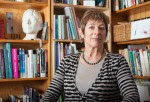Don’t do what I do; do what I say…
It wasn’t as if I could plead ignorance. I’d done the Alexander Technique course on how to sit properly and how to iron out the kinks in my spine every day. I’d been told about the importance of taking a break every thirty minutes. I also knew about Feldenkrais and yoga and callanetics and swimming and walking and tai chi.
But I had a pressing deadline, and I forgot about all that. I was writing a commissioned book, that last one on the history of the Churchill Trust—and as often happens, the project grew organically into something much bigger than anyone had envisaged at the beginning, and I simply had to get it done on time.
So every day I’d wake early, make a café au lait, and sit at my desk and type. I wrote for hours, maybe had a bit of lunch, made some phone calls to people I’d interviewed, or emailed them to make sure I had their facts correct, and basically, I’d sit at my desk until it was time for dinner (or way past it).
I didn’t have weekends, I didn’t go to dance practice or out on Saturday nights, and the breaks I had were mostly flinging myself on the sofa with a glass of cabernet sauvignon to watch The Gruen Transfer or boxed sets of Masters of Sex or Borgen.
My back felt odd sometimes, but I did about two minutes of Sarah Key’s back blockexercises before dinner, hoping it would be fine. This went on for months and months until one Saturday morning I decided to have a really good scrub at the shower tiles (I’d say the grout between them dates from when the house was built: 1962). I got down and scrubbed, and when I tried to jump up and go back to my desk, I howled in agony. I was stuck.
Sitting—the occupational hazard for writers
I had to crawl to the telephone for help, which came quickly. My osteopath made a home visit. After solving the initial problem, she recommended taking a break every 30 minutes of sitting. Walk around the house. Run on the spot for 30 seconds. Walk around the house again.
After the second 30 minutes, walk around the house again, run on the spot 30 seconds, and lie on your tummy with arms out in front and kick your legs as if you’re swimming, for 10–30 seconds. Get up and walk around the house again.
It’s awfully hard to break every 30 minutes when the deeper we are into a piece of writing, the more we want to stay with it. However, there are programs you can install on your computer—try the free apps, Awareness, Time Out Free, Breaker and Big Stretch Reminder.
The Alexander Technique
‘You translate everything, whether physical or mental or spiritual, into muscular tension,’ wrote F. M. Alexander (1869-1955). The Alexander Technique gives people practical skills to gain a high standard of poise, muscular tone and breathing for general wellbeing, management and prevention of injury, and postural and ergonomic issues. Canberra practitioners, Michael Stenning and Léonie John, have a studio in O’Connor, and more information on the Alexander Technique can be found on their website.
Feldenkrais Method
I was explaining to a friend about what we did in a Feldenkrais class and she said, ‘It sounds like tiny yoga’. That’s a good summary. This method, after Moshe Feldenkrais (1904-1984), improves posture, flexibility, coordination, self-image and alleviates muscular tension and pain. It promotes awareness of the body and gives the ability to move with grace and elegance, precision and power. Google for Feldenkrais classes in your area.
Tai Chi
Tai Chi improves posture and coordination, and increases circulation and flexibility. The teachers of Canberra’s Tai Chi Academy claim that it will make you ‘feel relaxed, calm and connected with your inner peace.’ Courses and DVDs are readily available and the graceful movements are a refreshing counter to too much desk work.
Sarah Key
Australian physiotherapist Sarah Key’s books on the back are excellent, as is her The Body in Action (Allen & Unwin, 2006). They have simple exercises and illuminating images on how our bodies work, how they go wrong, and how to prevent and cure injury. Sarah Key demonstrates her easy exercises on You Tube.
Meditation
Thousands of peer-reviewed studies show that mindfulness enhances mental and physical wellbeing and reduces chronic pain. Meditation decreases stress, improves memory, quickens reaction times, improves stamina and improves the immune system.
Dr Danny Penman wrote Mindfulness for Creativity (Piatkus, 2015), which includes a meditation CD. You can find out more at www.franticworld.com/resources
**
 Penny Hanley has been a film critic, book reviewer, artists’ model, caterer’s assistant, and deck hand on a yacht. Then after a 20 year editing career, she became a freelance writer. She has had a novel and 20 short stories published. Books commissioned include Creative Lives: Personal Papers of Australian Artists and Writers (NLA, 2009) andInspiring Australians: The first fifty years of the Winston Churchill Memorial Trust (ASP, 2015). She has a PhD in Communications from the University of Canberra and a BA (Hons) in English Literature from the Australian National University. Penny loves books, cinema, travel and dancing the Argentine tango.
Penny Hanley has been a film critic, book reviewer, artists’ model, caterer’s assistant, and deck hand on a yacht. Then after a 20 year editing career, she became a freelance writer. She has had a novel and 20 short stories published. Books commissioned include Creative Lives: Personal Papers of Australian Artists and Writers (NLA, 2009) andInspiring Australians: The first fifty years of the Winston Churchill Memorial Trust (ASP, 2015). She has a PhD in Communications from the University of Canberra and a BA (Hons) in English Literature from the Australian National University. Penny loves books, cinema, travel and dancing the Argentine tango.
This blog was originally published on the ACT Writers Centre’s blog, CAPITAL LETTERS, 22 August 2016.





